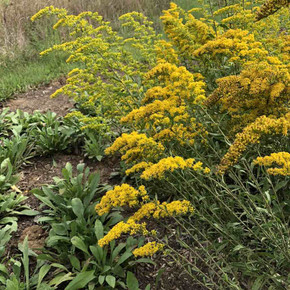

Please note your preferred ship date/week in the "Order Comments" section at checkout.
Otherwise, please allow 1-3 weeks to receive your order.
See the "Shipping" page under "Company Information" for our default ship dates based on hardiness zone.
We are unable to ship to any US Territories, AK, AZ, CA, CO, HI, ID, MT, NM, NV, OR, UT, WA, or WY
Upright and narrow goldenrod with reddish stems and narrow spikes of yellow flowers.
Blooming Time: August-September
Size: usually about 4' tall and 2' wide (in optimum conditions up to 5' tall, and in poor conditions only 2' tall)
USDA Zones: 3-7
Culture: Sun to half shade, average soil
Moisture Needs: medium, medium-moist, medium-wet to wet (prefers moister soil)
Origin: Midwest, Southeast and eastern Canada, see the BONAP distribution map. Likes moisture and can be found in bogs, marshes, wet meadows, fens and water margins.
Black Walnut Tolerant: yes
Deer/Rabbit Resistant: yes/yes
Attracts Butterflies or Pollinators: yes, attracts many butterflies, including Monarchs and various pollinators
Attracts Hummingbirds: no
Pot Size: square 3.5" x 4" deep perennial pot
Plant Combinations: For naturalistic plantings, pollinator or Monarch gardens, rain gardens, swales, for wet soil or meadow planting on wet or seasonally wet soils. Good companions on the slightly moist side can be Asclepias incarnata, Chelone, Eupatorium, Filipendula vulgaris, Helianthus, Helenium, Heliopsis, Iris (x lousiana, I. versicolor, I. virginica), Lysimachia, Mimulus, Phlox paniculata, Rudbeckia fulgida, Rudbeckia laciniata, Sanquisorba, Silphium, Solidago, Thalictrum, Veronicastrum and various sedges (Carex). Grass companions include Chasmantium, Panicum, Spartina pectinata. Can also be used with mounding plants like Amsonia, Baptisia, bigger cultivars of Hemerocallis, Hibiscus (H. moscheutos, H. leavis, H. palustris).
But will go well with other common perennials, especially on heavier soils that some hold moisture.
Picture copyright: Kristl Walek, Facebook
Upright and narrow goldenrod with reddish stems and narrow spikes of yellow flowers.
Blooming Time: August-September
Size: usually about 4' tall and 2' wide (in optimum conditions up to 5' tall, and in poor conditions only 2' tall)
USDA Zones: 3-7
Culture: Sun to half shade, average soil
Moisture Needs: medium, medium-moist, medium-wet to wet (prefers moister soil)
Origin: Midwest, Southeast and eastern Canada, see the BONAP distribution map. Likes moisture and can be found in bogs, marshes, wet meadows, fens and water margins.
Black Walnut Tolerant: yes
Deer/Rabbit Resistant: yes/yes
Attracts Butterflies or Pollinators: yes, attracts many butterflies, including Monarchs and various pollinators
Attracts Hummingbirds: no
Pot Size: square 3.5" x 4" deep perennial pot
Plant Combinations: For naturalistic plantings, pollinator or Monarch gardens, rain gardens, swales, for wet soil or meadow planting on wet or seasonally wet soils. Good companions on the slightly moist side can be Asclepias incarnata, Chelone, Eupatorium, Filipendula vulgaris, Helianthus, Helenium, Heliopsis, Iris (x lousiana, I. versicolor, I. virginica), Lysimachia, Mimulus, Phlox paniculata, Rudbeckia fulgida, Rudbeckia laciniata, Sanquisorba, Silphium, Solidago, Thalictrum, Veronicastrum and various sedges (Carex). Grass companions include Chasmantium, Panicum, Spartina pectinata. Can also be used with mounding plants like Amsonia, Baptisia, bigger cultivars of Hemerocallis, Hibiscus (H. moscheutos, H. leavis, H. palustris).
But will go well with other common perennials, especially on heavier soils that some hold moisture.
Picture copyright: Kristl Walek, Facebook
